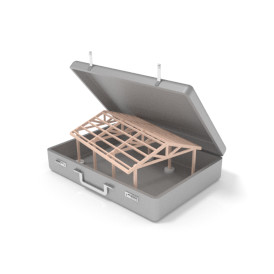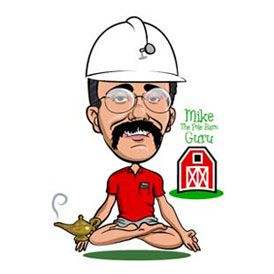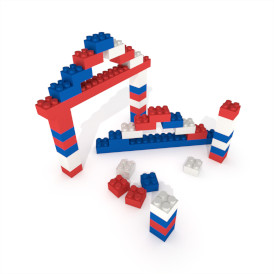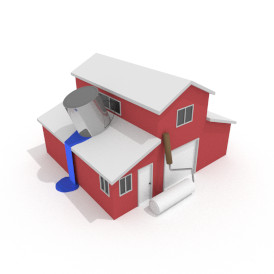Answers About Post-Frame Interior Concrete Slabs
American Concrete Institute (ACI) lists factors playing a role in how thick covering concrete must be to support rebar.
Cast-in-place concrete requires placement of wet concrete around rebar, then holding it in place as it sets and dries around it. This is usually done with rebar supports helping hold it at correct depths, but this does open it up to a certain level of operator error.
For cast-in-place concrete in contact with ground permanently, recommended covering concrete thickness is three inches.
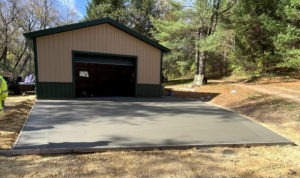 This means for cast-in-place slabs less than 5 inches thick, in most circumstances, there should be no rebar involved. Slabs at this thickness are simply too thin to adequately cover and protect rebar while still exploiting its reinforcing nature.
This means for cast-in-place slabs less than 5 inches thick, in most circumstances, there should be no rebar involved. Slabs at this thickness are simply too thin to adequately cover and protect rebar while still exploiting its reinforcing nature.
Use 6″ x 6″ x 10 gauge WWM (Welded Wire Mesh) in conjunction with fibermesh. A 3500 psi mix is more than adequate for most residential applications.
Shrinkage-reducing concrete admixture promotes concrete expansion at about same volume normal drying shrinkage is contracting it. Net change in hardened concrete length is small enough to prevent shrinkage cracks. Shrinkage reducing concrete mixture is typically comprised of polyoxyalkylene alkyl ether or similar composition.
When such admixture is added to concrete during the batching stage, it can significantly reduce both early and long-term drying shrinkage; reductions of 30 to 50% can be achieved. This is achieved by treating drying shrinkage ‘cause’ within cement paste capillaries and pores.
Shrinkage reducing admixtures are mainly based on ethylene glycol derivatives. These organic liquids are totally different to most other water-based admixtures.
These admixtures are normally 100% active and are water soluble. They have a characteristic odor and a specific gravity of less than 1.00.
Mechanism shrinkage reducing admixtures operate is unique. When excess water begins to evaporate from concrete’s surface after placing, compacting, finishing and curing, an air/water interface or “meniscus” is set up within concrete’s cement paste capillaries or pores.
Because water has a very high surface tension, this causes a stress to be exerted on capillary pore interior walls where this meniscus has formed.
This stress is inward pulling force tending to close up capillaries or pores. Thus, capillary volume is reduced leading to cement paste shrinkage around aggregates, leading to an overall reduction in volume.
Shrinkage reducing admixtures operate by interfering with air/water surface chemistry interface within capillaries or pores, reducing surface tension effects and consequently reducing shrinkage as water evaporates from within concrete.
Usage rates vary with batch designs and water content but typically range from 8 to 25%. Selection of an appropriate dosage would depend on shrinkage level desired, acceptable set retardation degree, and curing conditions.
Effects on Fresh Concrete
Increase slump value when 2% of this admixture is added to concrete mixture without adjustment.
It might retard the hydration rate slightly and extend setting time by an hour.
It influences concrete mixture air content. If concrete reducing admixture and air entraining admixture is added together, greater quantity of air entraining admixture should be used to achieve designated air content.
Effects on Hardened Concrete
Reduce shrinkage by 30 to 50%. This reduction is influenced by ambient conditions, mixture design, and materials used.
It causes concrete compressive strength reduction. It is demonstrated, blending 2% of shrinkage reducing admixture would lead to strength reduction by 15% at 28 days. Strength reduction can be offset by reducing water to cement ratio or adding high range water reducing admixture.
Reduce thermal cracking.
It decreases concrete slab curling.
Capacity of shrinkage reducing concrete admixture to minimize cracks would allow it to decline both joint contraction and curling.
Shrinkage reducing concrete admixture offset high-shrinkage aggregate influences. In this case, cost comparison between shrinkage reducing concrete admixture cost and good quality aggregate should be made to specify economic options.
Shrinkage reducing admixtures can be used in situations where shrinkage cracking could lead to durability problems or where large numbers of shrinkage joints are undesirable for economic or technical reasons.
I would avoid calcium chloride as an additive – concrete mixed with calcium chloride has a tendency toward future damage than concrete without this chemical. Chloride can cause the mix to shrink as it cures, creating surface cracks. There is also an increased scaling risk in concrete made with chloride accelerators.
Do not pour on frozen ground. There are several reasons for not placing concrete on a frozen subgrade. Some soils expand or heave when they freeze. When they thaw later, ground subsides and the slab loses subgrade support. This can cause concrete to crack.
If flatwork is placed on frozen ground there’s another danger. Cold concrete at bottom takes longer to set than near surface concrete. Surface crusts over and looks like it’s ready to finish while the rest of concrete isn’t firm enough to support the finishers’ weight. Concrete may bulge out underneath the power trowel, creating a wavy surface. Or the surface may crack.
Finally, there’s a possibility that a cold subgrade will freeze concrete in contact with it. Freezing damages green concrete.
Control joints are joints placed by concrete pouring crew as part of their installation process. This means at day’s end, when they pour, or first thing next morning, they run a saw along concrete to create a cut line. This joint line’s purpose is simply to impart a weakened plane in concrete, so concrete cracks, at predetermined points. This process hides inevitable concrete cracks in a linear grid pattern. You are controlling cracking. Note concrete still cracks, it’s just at joint bottom.
Why fill them? Filled control joints in polished and stained concrete floors provided an easier to clean surface. In wheeled traffic environments, filler will act to protect joints from future chipping or damage, and provide a smoother transition.
What do you fill them with? Most common filler for these is a two-part colored polyurea product. This is a semi-hard filler, more hard than flexible.
In new construction, there are a lot of moving pieces. As concrete cures and initial moisture is pulled from the surface, there will be shrinkage occurring. Wait as long as possible to fill these joints. Ideally, it is towards the end of the construction process. If you don’t, joints may look good on installation day but will break away from concrete when the building is conditioned and dried out.
Tag Archives: Welded Wire Mesh
Many concrete finishers have switched to synthetic fiber mesh reinforcement for concrete slabs to help reduce surface cracking. In doing so, many of these finishers have completely eliminated traditional welded wire mesh (WWM).
But while fiber mesh has advantages, it also comes with potentially costly drawbacks.
This may sound surprising, given fiber mesh’s big appeal is its time and money savings. By using it, finishers don’t have to pay a premium for WWM, and don’t have to take time to correctly install it. Some concrete finishers actually offer a price break for fiber mesh.
While fiber does reduce surface cracking, it won’t eliminate cracks completely. Worse, when a crack does develop, lack of WWM can be a real weakness.
This is because properly installed WWM will keep concrete on both sides of a crack from separating further and will keep them on the same plane— preventing differential settling. Fiber mesh won’t.
Repairs to differential settling don’t leave a great impression on new post frame building owners. You have to grind down the surface on either side of the crack, fill the gap with epoxy and try to smooth it all out. Even when done well, this leaves a visible scar.
While such scars are mostly cosmetic, they scream “poor workmanship” to clients, leading many to doubt the slab’s structural integrity.
As the use of fiber mesh has grown, more and more of these problems have been seen on job sites, however finishers are beginning to take notice. Soon after switching to fiber mesh, one found a dozen cracking and settling slabs at a given time. They reintroduced WWM and these problems virtually disappeared.
Chances of differential settling depends largely on underlying soils. Where soil is sandy and stable, settling is less likely and fiber alone can be a reasonable choice.
However, in areas with clay and other expansive soils, correcting problems caused by elimination of WWM can cost more in the long run than initial cost savings associated with fiber mesh.
In fact, the best way to minimize chances of cracking and settling is to use fiber mesh and WWM together.
Like any structural product, WWM won’t do its job unless it’s installed correctly. Unfortunately, this is not always done.
Proper installation to provide maximum strength requires mesh to be raised off the ground so when concrete sets, it is in the slab’s depth lower third. This means placing WWM on chairs to hold it at the correct height.
It is crucial to ensure WWM be placed on proper height chairs. Otherwise, WWM will not effectively hold the slab together.
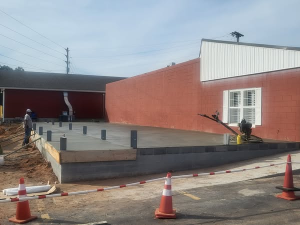 Wire not placed on chairs will not be effective. But in a rush to get jobs done, some crews eliminate chairs and roll WWM directly out over Code required under slab plastic sheeting covering underlying properly compacted fill. And when installers do use chairs, they must take care not to knock WWM off the chairs during pour. If they do, then they need to reset WWM.
Wire not placed on chairs will not be effective. But in a rush to get jobs done, some crews eliminate chairs and roll WWM directly out over Code required under slab plastic sheeting covering underlying properly compacted fill. And when installers do use chairs, they must take care not to knock WWM off the chairs during pour. If they do, then they need to reset WWM.
Making sure all of this gets done right can be a training and quality assurance challenge for finishers, and avoiding this challenge may be one reason why so many opt for synthetic fiber for these applications.
However, in soils or poorly prepared sites making settling likely, this type of oversight really needs to be a priority.
